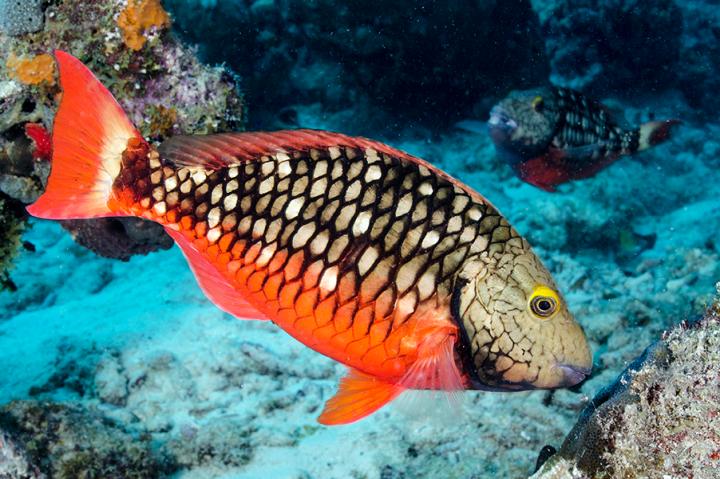
Credit: José Alejandro Alvarez
The rich biodiversity of coral reefs even extends to microbial communities within fish, according to new research. The study in Proceedings of the Royal Society: Biological Sciences reports that several important grazing fish on Caribbean coral reefs each harbor a distinct microbial community within their guts, revealing a new perspective on reef ecology.
“If you go snorkeling on a coral reef, you would never know about this incredible ecosystem feature because microbial communities are concealed to the naked eye,” said Douglas Rasher, a senior research scientist at Bigelow Laboratory for Ocean Sciences and the senior author of the paper. “But the microbiome appears to be a defining feature of each herbivorous fish species, as unique as its size or feeding behavior.”
Rasher and collaborators from the Smithsonian Tropical Research Institute, the University of California Santa Barbara, and Florida International University documented the feeding behaviors of five common Caribbean fish species and found that they markedly differ in what they eat and where they feed on the reef. Using advanced genetic sequencing and computing techniques, the researchers identified the microbes collected from within each fish’s gut – and discovered that each herbivore species harbors a unique gut microbiome.
The team found that some members of the gut microbiome probably live broadly throughout the ocean, while others appear to be resident microbes that may have symbiotic relationships with the fish. These “symbionts” need an animal host to live in – and though some thrived in multiple fish species, the researchers found that they often were unique to just one.
“It’s well known that each herbivorous fish species you see grazing on the reef eats different things and plays a unique role in the ecosystem,” Rasher said. “However, differences between these fish species are equally striking when you look at their respective gut microbiomes, so it really makes you wonder how much symbiotic microbes influence the way that these fish feed.”
Grazing fish keep coral reefs free of harmful algae, and the scientists’ previous research showed that a diverse portfolio of fish is needed to carry out this process. Though thousands of different microbes may thrive inside a fish’s gut at once, the researchers found that only 59 total types of microbes dominated the guts of the five fish species they studied.
Although the likely symbionts that the scientists discovered had never been identified before, genetic testing revealed that their closest known relatives are microbes living in the intestines of other reef fish. The team mapped the genetic relationships among these microbes, offering a new perspective on the relatedness of fish and their ecology around the globe.
“Our symbionts were remarkably similar to microbes found within the guts of related fishes in other, distant oceans,” said Jarrod Scott, a postdoctoral researcher at the Smithsonian Tropical Research Institute and the lead author of the paper. “Such a finding indicates that herbivorous fishes that are separated by millions of years of evolution and thousands of kilometers nonetheless harbor similar microbes.”
Just like humans and other land animals, fish digest their food with help from microbes living in their guts, which help to capture energy and nutrients and even break down plant toxins. This study suggests that fish microbiomes may also be ecologically and evolutionarily important on a global scale.
Scott, Rasher, and their collaborators hope to build upon their work by revealing the functions of symbionts in the gut, and how specific microbes aid their fish hosts. The other authors of this paper include Research Scientist Tom Adam and Professor Deron Burkepile from University of California Santa Barbara, and Affiliate Researcher Alain Duran from Florida International University.
“Our study is an exciting advance that sets the stage for future research in this area,” Rasher said. “Treating microbiomes as a fundamental characteristic of fish can help us understand how the ocean functions and the hidden roles of microbes in nature.”
This work was supported by philanthropic gifts to Bigelow Laboratory for Ocean Sciences, and by the Gordon and Betty Moore Foundation.
Media Contact
Steven Profaizer
[email protected]
Original Source
https:/
Related Journal Article
http://dx.




